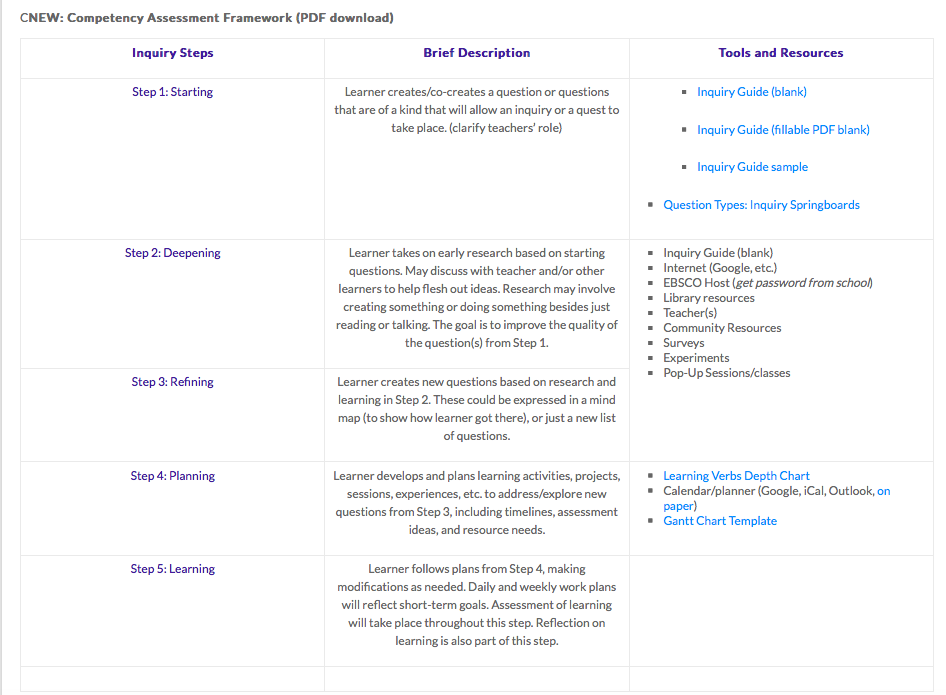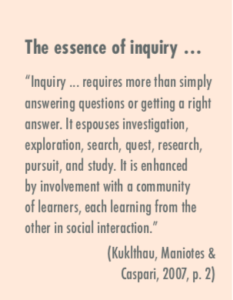Inquiry-based learning
Characteristics
An Inquiry based approach to learning is one where a teacher uses the students’ strengths and creates a plan in order to follow a student-centered approach. According to Ireland et al., (2014), there are 3 categories of inquiry the experience-centered approaches, the problem centered approaches and the question centered approaches. Under each of these categories there are subareas. As such please see the following diagram that explains the structure of inquiry categories imposed by Ireland et al., (2014):

Some other examples include the following photo which describes the various levels of inquiry as described by Trevor Mackenzie in the following photo:
Personalized Learning Using the Types of Student Inquiry
Here are some known Inquiry educators amongst Vancouver Island.
– Rebecca Bathurst, http://rebeccabathursthunt.com, she works in a Kindergarten classroom and follows this approach. Her Inquiry Mindset book which was written with Trevor Mackenzie is a very valuable resource. As well as her Instagram page.
– As well as PSII follows an Inquiry based approach (my brother actually attends PSII). To learn more about their approach, you can search Jeff Hopkins and listen to his TedTalks. Jeff also provides a fantastic diagram that shows us how to start an inquiry project. Here is a great resources for students and teachers to begin an inquiry project.
(photo retrieved from: http://learningstorm.org/inquiry-tools/)

All in all, “Inquiry … requires more than simply answering questions or getting a right answer. It espouses investigation, exploration, search, quest, research, pursuit, and study. It is enhanced by involvement with a community of learners, each learning from the other in social interaction.” (Kuklthau, Maniotes & Caspari, 2007, p. 2). As such, this approach helps expand the learning to go beyond the curriculum. It also engages student to value their strengths and work at their own pace. An Inquiry approach supports the diversity of student learners as it allows each individual to prosper at their own level and explore in more of a personable and in-depth manner. The following video addresses some of the key aspects to building an inquiry mindset and teaching approach https://www.youtube.com/watch?v=ICi2o0VfPl8.
My opinions on Inquiry-based Learning
In regards to inquiry based learning, I am a firm believer as I have found that inquiry allows students to seek and explore subjects more in depth it also allows students to be at the centre of their learning as they create their plan related to their interests and strengths. Furthermore, it fosters creativity and engagement. When seeing my brother’s projects and the process (he attends PSII), I truly value how the students are experiencing and using tools. As such, it is a very hands-on and cross curricular approach which helps support ALL students through a very inclusive and personalized approach.
Finally, here is another useful video as it shows an Inquiry model in the classroom and it addresses various perspectives around the benefits of this model for both students and teachers. https://www.youtube.com/watch?v=mAYh4nWUkU0
Association to blueprint and final assignment topic
Furthermore, an inquiry approach does align with our project topic as our project focuses on center-based learning; where students will learn about the water cycle through various centre activities. Students will be able to explore and make connections, thus allowing them to follow a “Structured Inquiry model”.
Place in your final Interactive Learning Design
I believe Inquiry has a place in every design as it supports students to engage and explore subjects more in-depth. However, I do think that the experiential and collaborative models are more in line with our designed lesson plan as the children are learning from each other within the stations and trying out things to see what works and what does not. As such, I have included a resource that discusses some of the differences between Inquiry and Experiential approaches (https://nifa.usda.gov/sites/default/files/resource/Inquiry%20Based%20Learning%20Methods.pdf)
References
Ireland, J., Watters, J. J., Brownlee, J. L., & Lupton, M. (2014). Approaches to Inquiry Teaching: Elementary teacher’s perspectives. International Journal of Science Education, 36(10), 1733–1750. https://doi.org/10.1080/09500693.2013.877618
Other Useful Teaching Resources
http://www.edu.gov.on.ca/eng/literacynumeracy/inspire/research/cbs_inquirybased.pdf
https://nifa.usda.gov/sites/default/files/resource/Inquiry%20Based%20Learning%20Methods.pdf
Inquiry Tools







Recent Comments